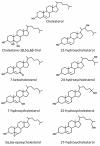Mechanisms of oxysterol-induced carcinogenesis
- PMID: 21388551
- PMCID: PMC3061933
- DOI: 10.1186/1476-511X-10-44
Mechanisms of oxysterol-induced carcinogenesis
Abstract
Oxysterols are oxidation products of cholesterol that are generated by enzymatic reactions mediated by cytochrome P450 family enzymes or by non-enzymatic reactions involving reactive oxygen and nitrogen species. Oxysterols play various regulatory roles in normal cellular processes such as cholesterol homeostasis by acting as intermediates in cholesterol catabolism. Pathological effects of oxysterols have also been described, and various reports have implicated oxysterols in several disease states, including atherosclerosis, neurological disease, and cancer. Numerous studies show that oxysterols are associated with various types of cancer, including cancers of the colon, lung, skin, breast and bile ducts. The molecular mechanisms whereby oxysterols contribute to the initiation and progression of cancer are an area of active investigation. This review focuses on the current state of knowledge regarding the role of oxysterols in carcinogenesis. Mutagenicity of oxysterols has been described in both nuclear and mitochondrial DNA. Certain oxysterols such as cholesterol-epoxide and cholestanetriol have been shown to be mutagenic and genotoxic. Oxysterols possess pro-oxidative and pro-inflammatory properties that can contribute to carcinogenesis. Oxysterols can induce the production of inflammatory cytokines such as interleukin-8 and interleukin-1β. Certain oxysterols are also involved in the induction of cyclo-oxygenase-2 expression. Inflammatory effects can also be mediated through the activation of liver-X-receptor, a nuclear receptor for oxysterols. Thus, several distinct molecular mechanisms have been described showing that oxysterols contribute to the initiation and progression of cancers arising in various organ systems.
Figures



Similar articles
-
The Role of Oxysterols in Human Cancer.Trends Endocrinol Metab. 2017 Jul;28(7):485-496. doi: 10.1016/j.tem.2017.03.002. Epub 2017 Apr 12. Trends Endocrinol Metab. 2017. PMID: 28410994 Free PMC article. Review.
-
Analysis of cholesterol oxidation products in biological samples.J AOAC Int. 2004 Mar-Apr;87(2):467-73. J AOAC Int. 2004. PMID: 15164842
-
Evidence of cell damage induced by major components of a diet-compatible mixture of oxysterols in human colon cancer CaCo-2 cell line.Biochimie. 2013 Mar;95(3):632-40. doi: 10.1016/j.biochi.2012.10.011. Epub 2012 Oct 22. Biochimie. 2013. PMID: 23092829
-
Oxysterols and atherosclerosis.Atherosclerosis. 1999 Jan;142(1):1-28. doi: 10.1016/s0021-9150(98)00196-8. Atherosclerosis. 1999. PMID: 9920502 Review.
-
Comparison of the cytotoxic, pro-oxidant and pro-inflammatory characteristics of different oxysterols.Cell Biol Toxicol. 2005 Mar;21(2):97-114. doi: 10.1007/s10565-005-0141-2. Cell Biol Toxicol. 2005. PMID: 16142584
Cited by
-
Oxysterols of helminth parasites and pathogenesis of foodborne hepatic trematodiasis caused by Opisthorchis and Fasciola species.Parasitol Res. 2020 May;119(5):1443-1453. doi: 10.1007/s00436-020-06640-4. Epub 2020 Mar 23. Parasitol Res. 2020. PMID: 32206886 Review.
-
Elevated prevalence of Helicobacter species and virulence factors in opisthorchiasis and associated hepatobiliary disease.Sci Rep. 2017 Feb 15;7:42744. doi: 10.1038/srep42744. Sci Rep. 2017. PMID: 28198451 Free PMC article.
-
Inhibition Role of Atherogenic Diet on Ethyl Carbamate Induced Lung Tumorigenesis in C57BL/6J Mice.Sci Rep. 2017 Jul 5;7(1):4723. doi: 10.1038/s41598-017-05053-1. Sci Rep. 2017. PMID: 28680122 Free PMC article.
-
Effects of 7-ketocholesterol on tamoxifen efficacy in breast carcinoma cell line models in vitro.J Steroid Biochem Mol Biol. 2023 Sep;232:106354. doi: 10.1016/j.jsbmb.2023.106354. Epub 2023 Jun 19. J Steroid Biochem Mol Biol. 2023. PMID: 37343688 Free PMC article.
-
Helminth infection-induced malignancy.PLoS Pathog. 2017 Jul 27;13(7):e1006393. doi: 10.1371/journal.ppat.1006393. eCollection 2017 Jul. PLoS Pathog. 2017. PMID: 28750101 Free PMC article. Review. No abstract available.
References
Publication types
MeSH terms
Substances
Grants and funding
LinkOut - more resources
Full Text Sources
Medical

